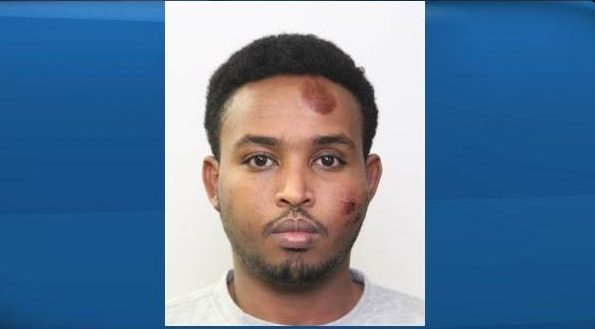The RCMP’s acknowledgement that it had investigated Abdulahi Hassan Sharif, the Edmonton terror attack suspect, in 2015 but didn’t think he posed a threat has raised the question: How do police decide which extremists to take seriously?

Sharif, a 30-year-old Somali refugee, has been charged with five counts of attempted murder and other offences stemming from Saturday night’s attack, police said on Monday. He was not charged with terrorism. The RCMP said the investigation was continuing.
But long before he allegedly put an ISIS flag in his car, drove at an Edmonton police officer, got out to stab him and then rammed four pedestrians with a U-Haul truck, Sharif had already come to the attention of police.
Watch below: Edmonton police released security video showing a car ramming into a police officer and the suspect getting out of the vehicle to stab the officer. WARNING: Video contains disturbing images.

A complaint to the Edmonton Police Service in 2015 alleging Sharif was “espousing extremist ideology” triggered an investigation by the RCMP’s Integrated National Security Enforcement Team in Alberta, police said.

Get breaking National news
Following what the RCMP called an “exhaustive investigation,” no terrorism charges were laid. Police did not seek a peace bond against him. Nor did they deem him a threat to national security.
“The RCMP and our partners at the Edmonton Police Service are confident that the 2015 allegations were investigated to their fullest,” RCMP Assistant Commissioner Marlin Degrand told reporters on Sunday.
“The suspect showed no signs of active recruitment or radicalization to violence at that time,” Degrand said at an Edmonton news conference. “We had no intelligence that warranted keeping this suspect under investigation any further.”
Police had no further interactions with him until Saturday, he said.
Police get hundreds of tips about extremists, often from family and friends, not to mention from police in other countries. To distinguish the real threats from the big talkers, police conduct what are called assessments.
Watch below: Ralph Goodale says suspect in Edmonton attacks had “some appearance” on police watch list

“Where we start becoming concerned is where an individual radicalizes to violence,” Assistant Commissioner James Malizia, who oversees the RCMP national security program, said in a recent interview.
“So we start assessing and looking for indicators for mobilization to terrorism,” he said.
“Are they actually preparing to do something? Are they acquiring weapons? What state of mind are they in? Have they made statements to friends or family, or posted them online, that we should be concerned about?”
One of the assessment tools used by the RCMP is named VERA-2. It’s a sort of checklist. Suspects are rated either low, medium or high on factors ranging from their attachment to violent ideology and level of alienation from society to their need for group belonging and sense of empathy.
“We’re basically trying to determine, on a scale of one to 10, is the person a one or a 10?” said Phil Gurski, a former Public Safety Canada expert on radicalization.
“What amount of resources are required to look at this guy? Is this person really a danger or are they just dipping their toe in the water?”
READ MORE: Edmonton cop protected his gun from terror suspect while fending off knife attack
Depending on the answer, police might refer someone to a prevention program like those in Calgary, Montreal and Toronto. For more serious cases, they might conduct surveillance and recruit sources. Eventually, they might obtain a peace bond or lay charges.
Or they might not have enough to do anything, as was apparently the case with Sharif.
It’s an imperfect system. Both Aaron Driver and Martin Couture-Rouleau were investigated for extremism but neither were considered imminent threats. And yet Driver went on to attempt a suicide bombing for ISIS in August 2016 and Couture-Rouleau killed a Canadian Forces member in October 2014.








Comments